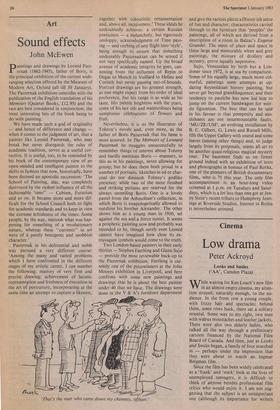Art
Sound effects
John McEwen
aintings and drawings by Leonid Past-
ernak (1862-1945), father of Boris, is the principal exhibition of the current wide- ranging selection offered by the Museum of Modern Art, Oxford (all till 30 January). The Pasternak exhibition coincides with the publication of the English translation of his Memoirs (Quartet Books, £12.95) and the two are best considered in conjunction, the most interesting bits of the book being to do with painting.
We have made such a god of originality — and hence of difference and change when it comes to the judgment of art, that a painter like Leonid Pasternak, who may break but never disregards the rules of academic tradition, serves as a useful cor- rective. It is useful, too, to be reminded by his book of the contemporary view of an open-minded and intelligent painter to the shifts in fashion that now, historically, have been decreed an apostolic succession: 'The School of Painting, alas, was completely destroyed by the violent influence of all the fashionable 'isms" — Cubism, Futurism and so on. It became more and more dif- ficult for the School Council both to fight for academic standards and to keep in view the extreme leftishness of the times. Some people, by the way, mistook what was hap- pening for something of a revolutionary nature, whereas these "currents" in art were of a purely bourgeois and snobbish character.'
Pasternak in his deferential and noble way pursued a very different course: 'Among the many and varied problems which I have confronted in the different stages of my artistic career, I can number the following: mastery of very firm and precise drawing; achievement of laconic representation and freshness of execution in the art of portraiture, incorporating at the same time an attempt to capture a likeness, together with colouristic ornamentation and, above all, incisiveness.' These ideals he undoubtedly achieves: a certain Russian poeticness — a melancholy, but rigorously unsloppy, acknowledgment of Time pass- ing — and curbing of any flight into 'style', being enough to ensure that something undeniably Pasternakian can be sensed if not very specifically named. Up the broad avenue of academic integrity he goes, can- noning from the influence of Repin to Degas to Munch to Vuillard to Helleu and Corinth but never passing out-of-bounds. Portrait drawings are his greatest strength, as one might expect from his order of ideal preference, but his range is as wide as his taste. His palette brightens with the years, some of his last oils and watercolours being sumptuous celebrations of flowers and fruit.
Nevertheless, it is as the illustrator of Tolstoy's novels and, even more, as the father of Boris Pasternak that his fame is most assured. In The Memoirs of Leonard Pasternak he struggles unsuccessfully to remember things of interest about Tolstoy and hardly mentions Boris — manners, in this as in his paintings, never allowing for gossip; but he does them both proud in a number of portraits. Sketches in oil or char- coal do not diminish Tolstoy's godlike presence; while two of the most finished and striking pictures are reserved for the always unsmiling Boris. One is a lovely pastel from the Ashmolean's collection, in which Boris is unapologetically allowed to outshine his brother Alexander. The other shows him as a young man in 1910, set against the sea and a fierce sunset. It seems a prophetic painting now and probably was intended to be, though surely even Leonid cannot have imagined how close its ex- travagant symbols would come to the truth.
Two London-based painters in their early thirties — Stephen Farthing and Glenn Sujo — provide the most reviewable back-up to the Pasternak exhibition. Farthing is cur- rently one of the prizewinners at the John Moores exhibition in Liverpool, and here confirms with some new paintings and drawings that he is about the best painter under 40 that we have. The drawings were done in the V & A's furniture department 'That's the man who came down my chimney, officer.'
and give the various pieces a Disney-ish sense of fun and character; characteristics carried through to the furniture that 'peoples' the paintings, all of which are derived from a description of a room in Balzac's Eugenie Grandet. The sense of place and space in these large and memorably white and grey paintings, the mixture of drollery and mystery, prove equally impressive.
Sujo, Venezuelan by birth but a Lon- doner since 1972, is at sea by comparison. Some of his equally large, much more col- ourful, paintings seem attempts at up- dating Reynoldsian history painting, but never get beyond grandiloquence; and their tendency to pastiche has now led him to jump on the current bandwagon for weir- do figuration. The best that can be said in his favour is that pomposity and mo- dishness are not insurmountable faults. 'MU/ZE/UM', an evolving installation by B. C. Gilbert, G. Lewis and Russell Mills, fills the Upper Gallery with sound and some leaves (among other things) and, to judge largely from its proposals, seems all set to be another quasi-religious magical mystery tour. The basement finds us on firmer ground indeed with an exhibition of texts and photographs in honour of Paul Rotha, one of the pioneers of British documentary films, who is 75 this year. The only film accompaniment is an hour-long video screened at 1 p.m. on Tuesdays and Satur- days, which is a lot less than one got at Jen- ny Stein's recent tribute to Humphrey Jenn- ings at Riverside Studios. Interest in Rotha is nevertheless aroused.


































 Previous page
Previous page